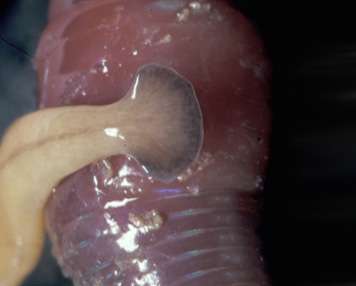A flatworm (Bipalium adventitium) subdues its prey, an earthworm 10 times larger in weight, by using its neurotoxin, tetrodotoxin. Biologists report the first evidence of the lethal compound in two terrestrial species. Credit: Utah State University
Adventurous fans of the sushi delicacy fugu – or pufferfish – already know the food's intoxicating tingle comes from tetrodotoxin, a potent neurotoxin that's deadly beyond small doses. What these diners and others didn't know, until now, is the toxin is found in organisms living out of water.
California State University, Bakersfield biologist Amber Stokes and colleagues report, for the first time, confirmation of the lethal compound, known as TTX, in terrestrial species.
With Utah State University colleagues Lorin Neuman-Lee, Charles Hanifin, Susannah French and Edmund "Butch" Brodie, Jr., along with Peter Ducey of the State University of New York, Cortland; Mike Pfrender of the University of Notre Dame and Edmund Brodie, III, of the University of Virginia, Stokes published findings of two flatworm species, Bipalium adventitium and Bipalium kewense, with TTX in the June 25, 2014, open access journal PLoS One.
The team's research was supported by the National Science Foundation.
"This study is the first to show tetrodotoxin in a terrestrial invertebrate," says Brodie, Jr., professor in USU's Department of Biology and the USU Ecology Center and Stokes' advisor during her graduate studies.
Tetrodotoxin acts by blocking electrical signals in both nerve and muscle tissue, resulting in paralysis and, in sufficient doses, death. Brodie has long studied varied species of North American garter snakes that have evolved an amazing resistance to TTX found in newts, a favorite food of the snakes.
"TTX is thought to originate in marine bacteria and may accumulate in certain organisms, such as pufferfish, through ingestion," Stokes says. "Some organisms may also produce it, but the origins and ecological functions of toxin in most taxa remain mysterious."
Stokes and her colleagues found the two flatworms in their study use TTX to subdue and feast on much larger earthworm prey.
"We also found the toxin in the egg capsules of one of the species," she says. "This may indicate a further role of TTX as a way of protecting offspring from opportunistic predators."
The authors say the study's findings will allow further investigation of the production or accumulation of the neurotoxin in terrestrial systems.
"This is really a novel finding," Stokes says. "These species add to our current knowledge and allow us further opportunities to explore where TTX comes from and how it is produced biochemically."
More information: Two Terrestrial Flatworm Species (Bipalium adventitium and Bipalium kewense). PLoS ONE 9(6): e100718. doi:10.1371/journal.pone.0100718
Journal information: PLoS ONE
Provided by Utah State University

-1.jpg)





















